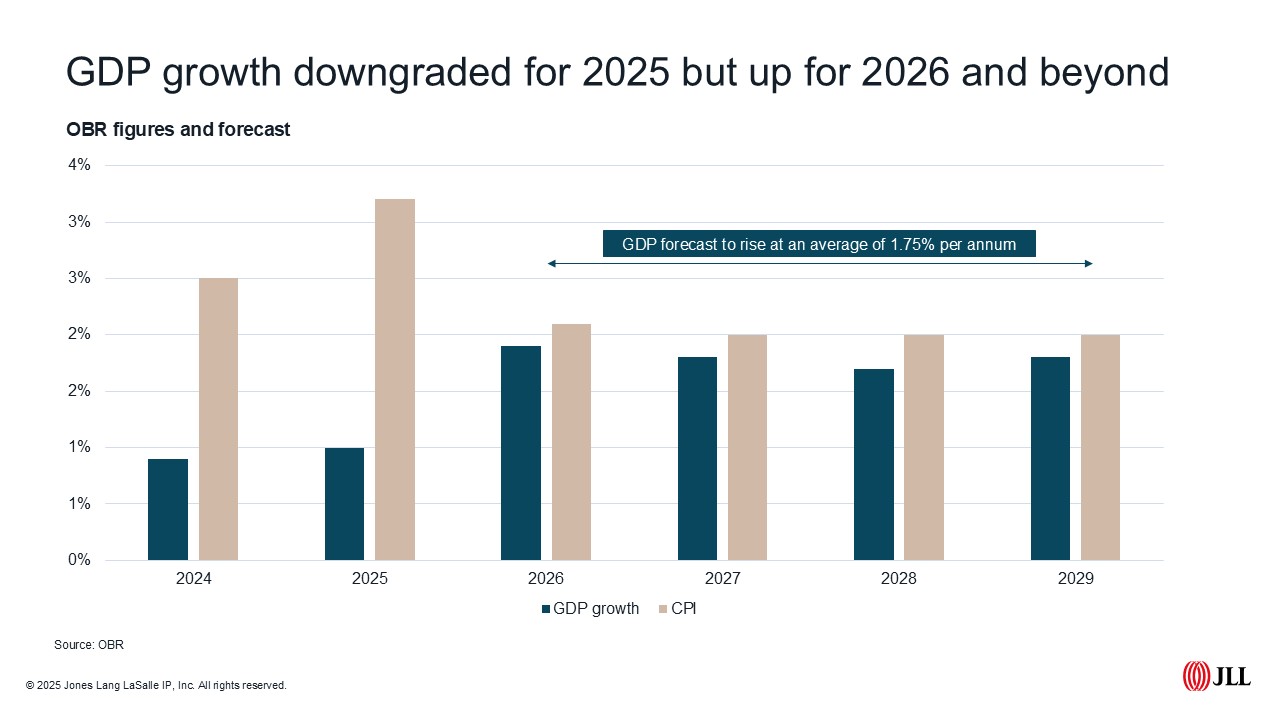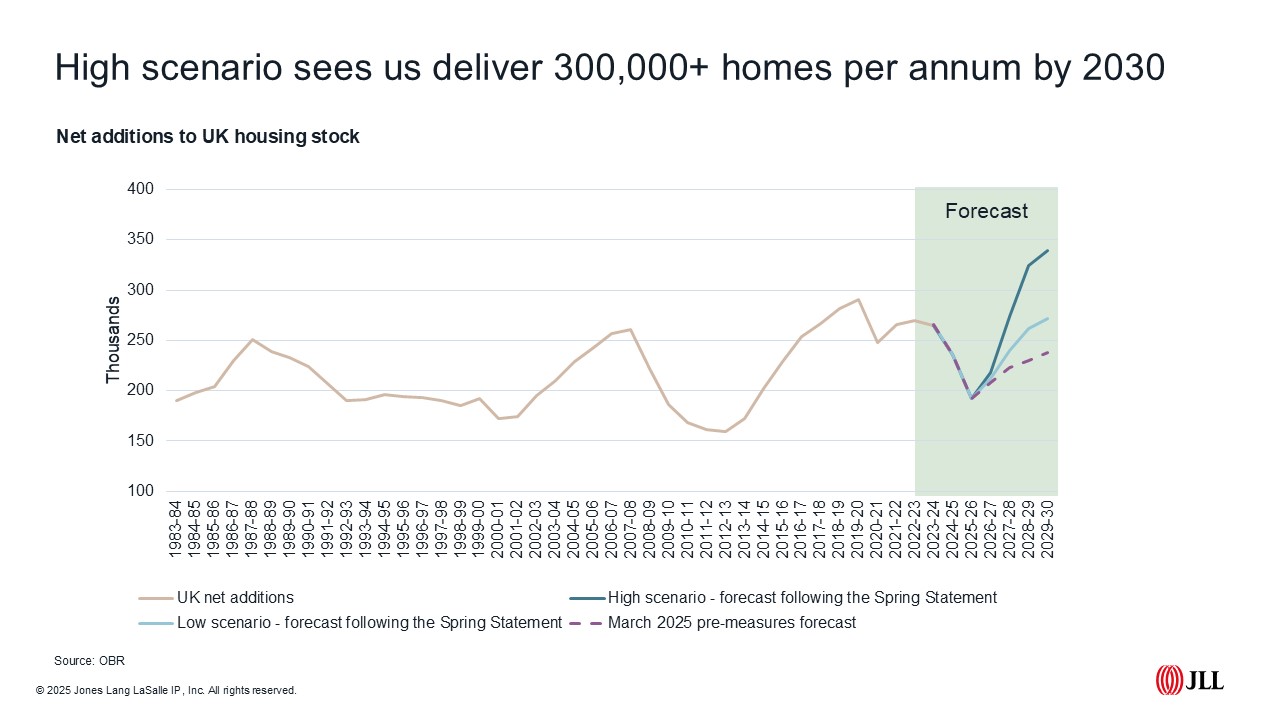Entering government Rachel Reeves committed to just one fiscal event a year. Yet in the run up to this Spring Statement it felt more like a mini budget (hopefully not like the last one) as we braced for the Office for Budget Responsibility end-of-term report on the UK economy.
Conditions are looking a little gloomier, at least in the short term. The outlook for UK GDP growth was cut from 2 per cent to 1 per cent for 2025. But the OBR had until now been more bullish on UK GDP than many other forecasters, with the consensus forecast on 2025 GDP growth sitting at 1.1 per cent pre-statement, closer to the revised OBR view.
There was better news beyond 2025, with the OBR upgrading their outlook for GDP growth from 2026 onwards, averaging 1.75 per cent per annum from 2026 to 2029. Fiscal headroom is expected to be restored to just shy of £10bn by 2029/30, albeit still tight in historic terms, leaving the door open for further tax hikes, or at the very least tweaks, later in the year.

Inflation comes in below expectation at 2.8 per cent
In what must have been welcome news for Labour’s front bench the latest inflation figures, released on the day of the Spring Statement, showed CPI dipping below 3 per cent to a lower than forecast 2.8 per cent in February. Core inflation (the measure which strips out food and energy) also defied expectations as it dropped back from 3.7 per cent in January to 3.5 per cent.
The OBR forecast that inflation will be higher than it previously expected this year, with 2025 CPI now expected to average 3.25 per cent, 60bps higher than the October forecast – a result of higher than anticipated rises in the cost of energy and food.
The jury is still out on what this means for the next meeting of the MPC – remember they chose to hold rates at the last one – but we expect that a further two to three 25bps cuts could still be on the cards in 2025.
Housing as a driver of growth
There were more namechecks for housing than we’d expected in the Spring Statement, cementing housebuilding’s role in Labour’s growth plans. We were already aware of some of the government’s announcements, including an additional slug of funds for affordable housing and money to support recruitment and training for the under-resourced construction sector, but the OBR view on the impact of planning reform made for interesting reading, too.
Building the construction workforce (£600m)
Combining government ambitions to build more homes with the considerable work underway to retrofit UK housing stock and rectify building safety has left the UK construction workforce stretched, before we even consider the significant increase in activity needed to get close to the Government’s 1.5 million homes target. But our construction workforce is ageing and set to shrink further at a time when demand is rising.
To stem this Rachel Reeves has announced a £600m investment in training the construction workers of the future. This investment is intended to provide 60,000 additional construction workers by 2029. The creation of a new Constructions Skills Mission Board will be set up to oversee the plans, with funds also being allocated for 10 new technical colleges and £165m earmarked for existing colleges to enable them to deliver more construction courses.
More money for affordable housing (£2bn)

A £2bn top up for affordable housing was announced pre-Spring Statement. The money is earmarked to provide an additional 18,000 affordable and social homes, equating to just over £111,000 per property. The £2bn follows two recent top
ups totalling £800m and is intended to provide a bridge between the 2021-2026 Affordable Housing Programme and the new grant funding scheme set to be announced at the spending review in June.
Touching distance of 1.5 million homes…
The OBR report provided some punchy forecasts for housing delivery, albeit coming with some degree of uncertainty and a fair few caveats. Revisions to the National Planning Policy Framework is expected to permanently increase the level of real GDP by 0.2 per cent by 2029/30 and boost housebuilding by 170,000 homes over the next five years.
OBR forecasts five-year UK-wide net additions ranging from 1.2 million (its low scenario) to 1.3 million (its high). Although worth noting this not only falls short of the 1.5 million target, but also that the target (1.5m) applies to England only. With England accounting for around 85% of UK net additions this suggests we could see between 1 million and 1.1 million homes delivered against the 1.5 million target.
More work needs to be done to unlock housebuilding, and while planning reform is part of that solution we’re holding out (and calling) for more demand side stimulus at the Spending Review in June.
JLL Research
JLL is a leading global professional services firm specialising in real estate and investment management, with $16.6bn annual revenue in 2020, operations in over 80 countries and a global workforce of over 90,000. With over 7,000 employees and 15 offices in the UK, we support our investor, developer, and occupier clients at every stage of the property lifecycle across both commercial and residential asset classes. This includes land purchase, access to capital, planning, development advisory, leasing, building management and sales.
JLL’s Residential and Living team consists of over 300 professionals who provide a comprehensive end-to-end service across all residential property types, including social housing, private residential, build to rent, co-living, later living, healthcare and student housing.
Disclaimer: © 2025 Jones Lang LaSalle IP, Inc. All rights reserved. Data within this report is based on material/sources that are deemed to be reliable and has not been independently verified by JLL. JLL makes no representations or warranties as to the accuracy, completeness or suitability of the whole or any part of the report which has been produced solely as a general guide and does not constitute advice. No part of this publication may be reproduced or transmitted in any form or by any means without prior written consent of JLL. JLL, its officers, employees shall not be liable for any loss, liability, damage or expense arising directly or indirectly from any use or disclosure of or reliance on such report. JLL reserves the right to pursue criminal and civil action for any unauthorized use, distribution or breach of such intellectual property.




